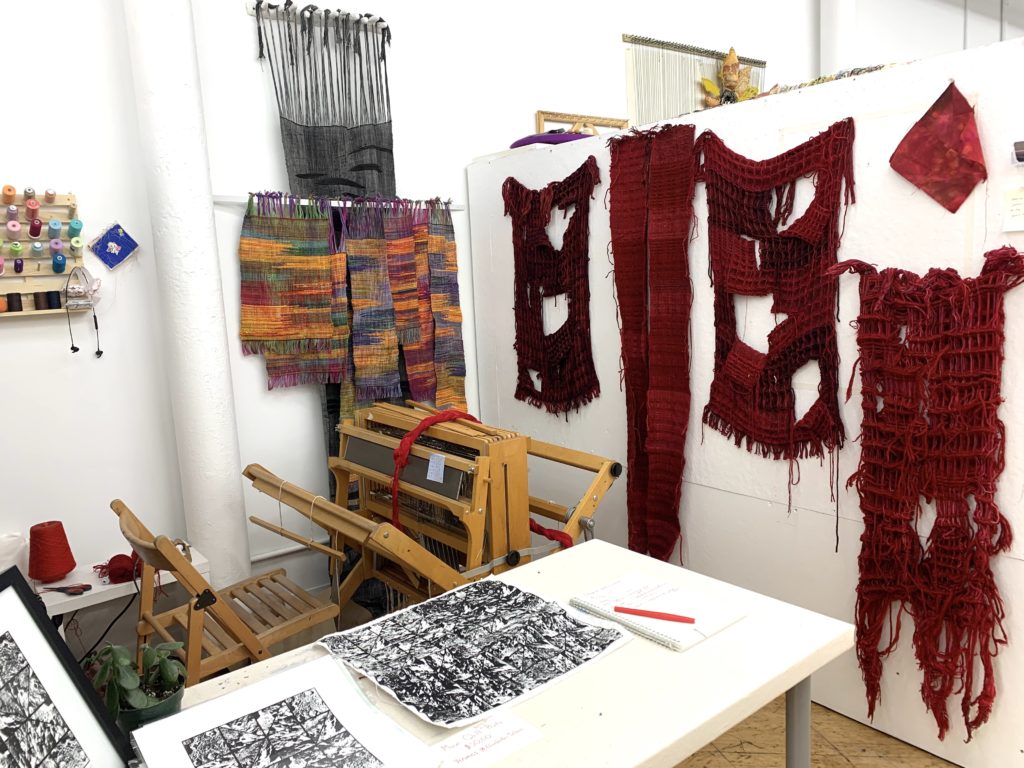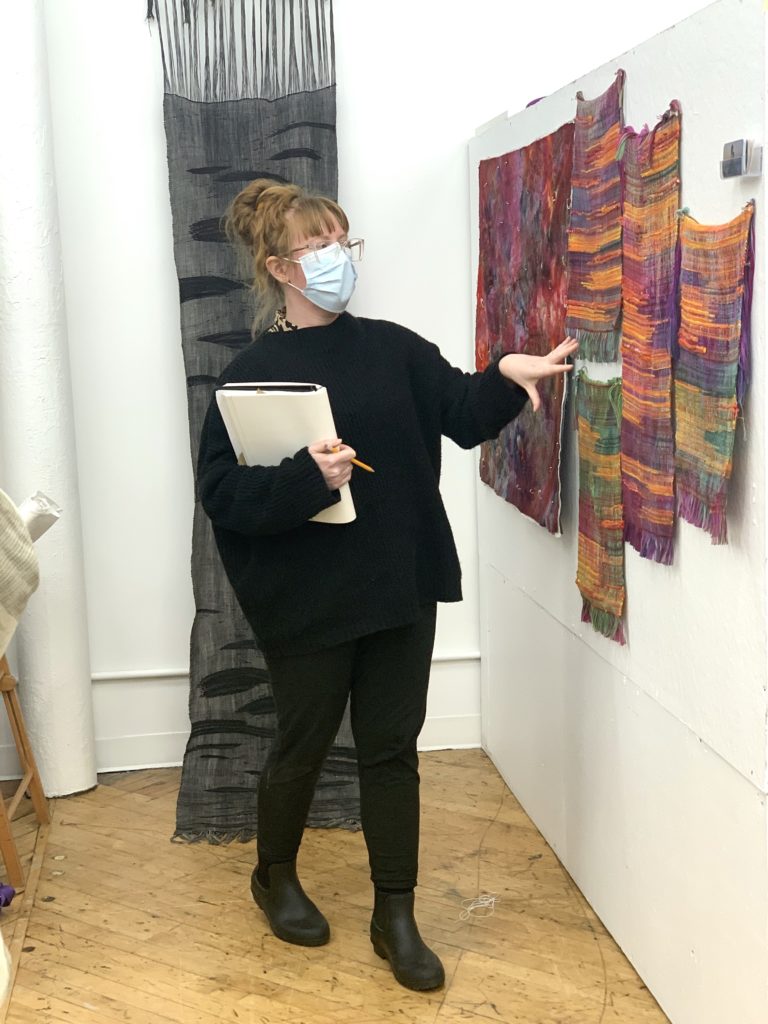AIR Highlight: Elizabeth Tolson
This conversation took place on June 29, 2021 at the Textile Arts Center with Elizabeth Tolson and Isa Rodrigues
Video Visual Description:
Footage of Elizabeth Tolson wearing an ice dyed multicolored t-shirt, with her blonde hair tied in a bun, and a light blue face mask. In the foreground on the right hand side is the blurry silhouette of Isa’s face and dark curly hair. The conversation is happening in one of the multi-use spaces at the Textile Arts Center, near the arched floor to ceiling windows, Elizabeth and Isa are sitting across from each other. In the background, on the walls, are some of Elizabeth’s works, including different sized quilts, made out of ice dyed fabrics in blue, yellow and red, and one red weaving.
Elizabeth Tolson (she/her) is an Artist and Educator who uses the language of textiles to explore the relationships between the moon, the body, and time. Tolson holds an MFA from Parsons School of Design and a BFA from Alfred University. She has participated in residencies at the Textile Arts Center, Trestle Projects, Chashama’s ChaNorth, Woodstock Byrdcliffe Guild, Open Wabi, and ProjectArt at the Bushwick Brooklyn Library. Exhibitions include the Textile Arts Center in Brooklyn, NY, Local Projects in Queens, NY, Target Gallery in Alexandria, VA, and Cuchifritos Gallery in New York City. She was a Guest Juror for the Textile Arts Center’s Work in Progress Residency. She has been a guest artist at Denison University and Alfred University. Her work is in the permanent collection of Van Every/Smith Galleries at Davidson College. Tolson is currently based in Brooklyn, NY where she is Part-time Faculty at Parsons School of Design and a Lead Teaching Artist at Brooklyn College Community Partnership.
Isa Rodrigues (she/her) is the co-Executive Director of the Textile Arts Center
Isa: Hi Elizabeth! I’m excited to be in conversation with you. Would you like to start by introducing yourself and telling us more about your work?
Elizabeth: Yes! Hello, my name is Elizabeth Tolson. I’m an artist and educator based in Brooklyn, New York. I’ve been working in textiles since about 2012. During my time at TAC I’ve been focusing on introducing new techniques into my practice, and then really focusing on the moon, the body and time and incorporating that into this new body of work that I’ve created while I’ve been here.
Isa: You mentioned you’ve been working with textiles for about 10 years. Can you tell us more about what drew you to fiber materials and techniques?
Elizabeth: So in 2012, I was actually working on my Masters degree at Parsons. I was doing a Design and Technology Masters and I started taking soft circuitry classes. And I really enjoyed them but a big thing was how can you embed the circuits into clothing. And I didn’t know how to sew clothing, and I didn’t really sew that much. So that’s when I really sort of jumped into it in my practice. And then also just growing up with my grandmother, we would sew a lot with her so I knew, you know, basic hand stitches and just how to operate a sewing machine, but not really like a ton. So when I was doing my Masters I really sort of dove into it, and tried to push myself in that way. But that was back when I was doing more light, embedding lights into garments and things like that.
Isa: Can you tell us more about that work with lights and garments? That was also a couple of years ago. With that work you were at a different residency here at TAC, the Work in Progress, and that was so incredible to see. Can you share a little bit more about the work that you’re doing then?
Elizabeth: Yes, I really loved making that work. It was very time consuming, it would take me about 5 months to really make a piece, on top of working outside of my studio practice. But I was making wearables that were supposed to be like, they were shells for the body. And so, they had LED strips embedded in them, and I could wear them out in different spaces and I was blending into that atmosphere, becoming one with my surroundings that way. And before then I was doing stuff with Arduino, and trying to add sensors into the garments that would react through, like movement, or through how hot you are, or light base sensors.
Isa: You mentioned earlier that during these last nine months you’ve been learning new techniques but also researching around the moon, body and time. Can you tell us more about how the new techniques you’ve been developing have informed these concepts?
(Elizabeth is pointing at the quilted work on the wall behind her)
Elizabeth: So if you look behind me here, on this piece, it’s a silk patchwork and then I’ve ice dyed. So I’m using ice and putting a powdered dye on top of it that slowly melts and it creates a very like freeform within the dye coming on to the silk fabric. I also learned that, I feel like silk takes dye better than cotton fabric, so that’s a fun fact (laughs). And then I’ve also learned how to weave, thanks to Isa. And I was really interested in waffle weaves ‘cus it’s almost like a tridimentional weaving. So I was experimenting a lot with that. When I was creating the weavings, I was thinking about the sense of time, and the body, and the uterine body. And I’m thinking about the layers within the uterus, and how over time the layers build up and then it’s slowly released, and that’s also a way for our bodies to count time. And so that was sort of the idea behind these works that I made, the red weavings.
(Pointing at a screen printed quilt on her lap)
And another technique that I learned how to do was screen printing, so I have that right here, ta da da.. (laughs) So I did the screen print, I actually used images of the Moon from NASA, and thenI used photoshop and I created a quilt, a triangle quilt piece. And I ended up burning it onto a screen and printing it. And I actually made risograph prints of this print. I really enjoyed learning how to do this. So also thinking about making this Moon surface without any stitching involved really, through the textures of the screen print. Yea, and I became really interested in the Moon because my grandfather was an engineer for NASA, so sort of like the Moon has always been, and Space has always been a big conversation in my family, and like a hot topic (laughs). So when I was thinking a lot about like how do I connect with the Moon within my body, my body connecting to the moon, that’s when I started to research and looking at menstrual cycles and the syncing of the menstrual cycle to the Moon cycle, it’s really fascinating to me. And also trying to recreate the surface of the Moon, and thinking about this space I’ll never be able to experience, and how do I sort of I bring that here and build it on my own. And the Moon is such a mysterious space.

Isa: One common element in your work has also been the practice of quilting. I’d love to hear more about the importance of that process and quilts in your work and also in your life.
Elizabeth: I became really drawn to quilts because my family has always had quilts. Like I had a bunch of quilts from when I was growing up. And I would say specifically my great great great grandmother was a huge quilter, (and) she had hundreds of grandchildren and great grandchildren but she made us all quilts. And so we all have these quilts and I’m just really drawn to, I mean there’s two reasons why, one within quilting it’s sort of like there’s this formula that you follow, it’s like this geometry, I was never good geometry (laughs), but I’m really into this formula and creating the structure; but then also when looking at my great great great grandmother’s quilts there’s no structure, no form, it’s just kind of like ‘let’s see what I have and how I can implement them into this practice of quilting’. And then a quilt is something that you make for somebody’s body and it can fit any body, it wraps around you… Yea, I’m just really drawn to quilting.
Isa: How has been your experience as a resident here at the Textile Arts Center? It’s not your first time, but it’s a different program. Do you have any highlights that you’d like to share?
Elizabeth: I feel like there’s a lot to share (laughs). During my time at the residency, I really looked at it as like this intensive MFA program and I just took all these classes and I just learned so much. And I also think because of the pandemic happening now, it added like this extra layer of ‘these are the only people I see, I’m finally leaving my house’ and getting back into my practice, because I sort of stopped making work for like 5-6 months before coming here. So it was just like a pick me up, I don’t know. It was just so nice to come here and just try new things, because it has been such a long time since I’ve really pushed and explored things, within my practice. And then just seeing everybody in the community, (it) was just so nice. I’m actually really sad to leave.
Isa: We're really sad that you’re all leaving too. (laughs)

Isa: In the last weeks we’ve been talking a lot and planning a lot for the final exhibition in September, which will be the culmination of the program. Can you share a little bit of what you’re planning to present in September?
(Elizabeth gets up and points at the quilts in the wall)
Elizabeth: Yes! And I actually have some samples right over here, if you want to take a look at the swatches. So I plan on making two larger quilts, so this is sort of just a little sample here. And the quilts will have a cut coming down them, and it’s going to fold over and reveal a quilt underneath. And the colors I want to use are these red ice dyed works, actually more like red and grey ice dyed. And then I have two other pieces that I will be showing and I may or may not be incorporating ceramics so… yay (laughs).
Isa: So Elizabeth, what’s next? Any future projects or plans for after the residency?
Elizabeth: One of my big things I need to do is, I need to establish a new studio somewhere. But I’ll probably wait until after the residency show because we have access to the space. And I’m not really sure… I guess, relax and spend time with my family and my dog, his name is Eugene (laughs). And yea, I guess I’ll start getting this body of work together and start applying for shows and things like that. And I’m going to keep exploring through techniques.
The TAC AIR 12 Final exhibition, Considering Mass and Density, will be on view at the Textile Arts Center from September 13-26, 2021.